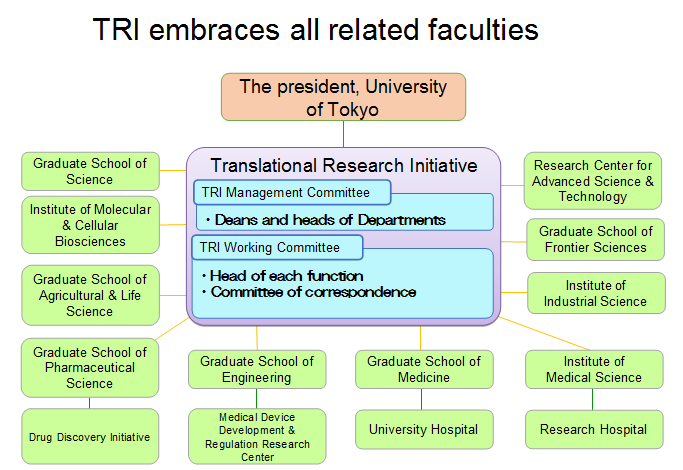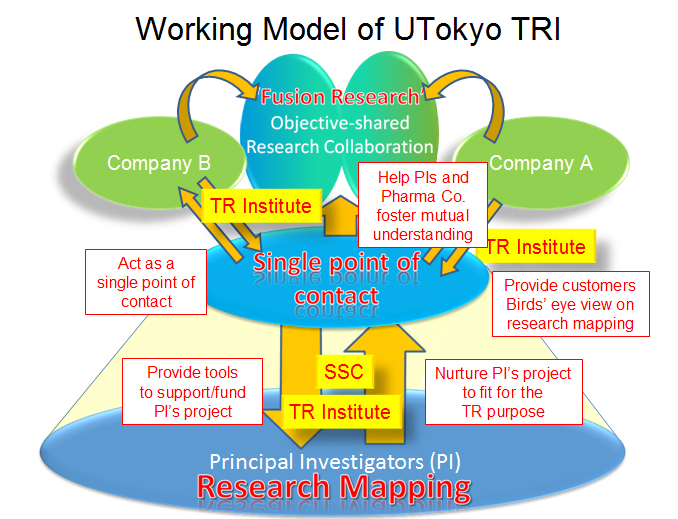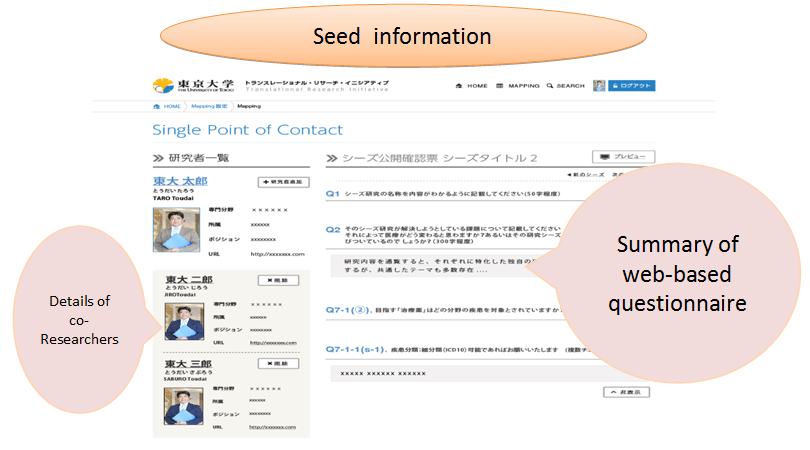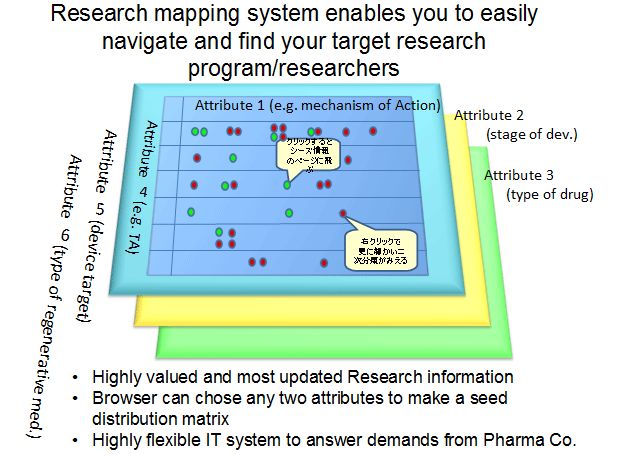
I. Organization
Translational Research Initiative, The University of Tokyo was founded in July 2007 under the Committee for Presidential Initiatives, with the aim of facilitating efficient research and development in advanced medicine―from fundamental research through to application and clinical practice.
The TR Initiative encompasses all medical-related research at UTokyo. Accordingly, the Initiative has been structured with the Office of the President overseeing the operations of the related graduate schools and institutes, as outlined in the diagram below. The TR Initiative Steering Committee is the highest decision-making body. Its members include the directors of all organizations involved in the program, as well as members specially appointed by the Committee―specifically, the Managing Director in charge of Research Promotion and Research Ethics, the Director of the TR Initiative (currently serving concurrently as Director of the University of Tokyo Hospital), Director of the University of Tokyo Hospital, Dean of the Graduate School of Medicine, Dean of the Graduate School of Pharmaceutical Sciences, Dean of the Graduate School of Science, Dean of the Graduate School of Agricultural and Life Sciences, Dean of the Graduate School of Engineering, Director of the Institute of Medical Science, Director of the Research Hospital, the Institute of Medical Science, Director of the Research Center for Advanced Science and Technology, Dean of the Graduate School of Frontier Sciences, Director of the Institute of Molecular and Cellular Biosciences, Head of Education and Research Support at the University of Tokyo Hospital.(No particular order; see diagram below.)

In addition, the University has established the TR Initiative Liaison Committee to enhance collaboration with the UTokyo departments handling tasks that have significant associations with the Initiative. By coordinating the operations of the TR Initiative with the strengths of the various university departments, UTokyo works to achieve the optimal approach to each project.
II. Basic Working Model of the TR Initiative
The TR Initiative has developed a working model in order to realize its mission. (See diagram below.)

In addition, the University has established the TR Initiative Liaison Committee to enhance collaboration with the UTokyo departments handling tasks that have significant associations with the Initiative. By coordinating the operations of the TR Initiative with the strengths of the various university departments, UTokyo works to achieve the optimal approach to each project.
Outline of Working Model
- Single Point of Contact
The TR Initiative functions as a single point of contact for TR-related matters at the University of Tokyo. This structure aims to improve accessibility for our partners outside the University.
You may wish to contact the University of Tokyo for a variety of reasons―for example, to contact the University or one of our researchers regarding TR-related matters, or to meet and discuss translational research in general with the University. Alternatively, you may wish to obtain factual information on a particular topic being researched at the University, or to discuss matters with an expert in the field. In any of the above cases, please direct your enquiries to UTokyo’s TR Initiative. You may, of course, maintain any existing communication channels you have established with UTokyo departments or faculty members. If you mention these existing relationships to the TR Initiative, we will work to provide additional support as needed.
In addition, this single point function helps UTokyo researchers to develop contact and collaboration, and also serves as a window for communicating any messages or notices from UTokyo researchers to businesses. - Research Mapping
In order to add value to the single point of contact structure outlined above, it is necessary to comprehensively identify all TR-related research conducted at UTokyo.
To this end, we have developed an algorithm-based “web question” form that is used with the cooperation of our researchers to gather details of each TR-related research project (SEEDS research) conducted at UTokyo, comprehensively and functionally. This SEEDS information is updated twice annually, and includes the latest information and seeds details not yet available through research papers or patent data. This data is categorized by seeds and by researcher. The database also includes firsthand information on the aims and policies of the research in question, gathered through face-to-face discussions with researchers. (see diagram below)


Next, we worked to create an overall picture of the SEEDS research conducted at the University of Tokyo, and created a Research Mapping Matrix System, which is extremely effective in locating individual seeds. This matrix system allows companies or external researchers to efficiently locate desired SEEDS research or researchers by selecting any combination of content search parameters (see diagram below). For example, searching for the parameters “treatment field” and “action mechanism” in combination brings up a list of relevant seeds on the matrix. You can then jump from the matrix to individual seeds data items that match your area of interest. Although there are naturally restrictions on the data that can be disclosed, this function serves as a “navigator” to help our partners locate the required research seeds or researchers.

- Steering and Science Committee (SSC)
The SSC is an expert advisory committee comprised of TR specialists from both within and outside the University. The Committee includes:
- Members with research and development experience at health care companies (both Japanese and non-Japanese companies: research, clinical development, pharmaceutical affairs) (several members)
- The head of legal affairs and licensing at a health care company
- former PMDA clinical reviewer
- The Representative of a patent attorney firm, with previous experience at the TLO of a national university
- A venture capital expert
- A consultant at a non-Japanese consulting firm (specializing in science and medicine)
The SSC provides a range of advice and guidance to UTokyo’s research programs with the aim of facilitating successful TR, and plays a key role in structuring research content with a view to practical application―an area in which academic research has traditionally been weak. Through these efforts, the Committee aims to improve the standard of each research project in order to produce data and services that meet the rigorous standards of the corporate world.
As the Committee includes former members of pharmaceutical companies as well as persons currently serving posts in their current professions, we have naturally set restrictions on the scope of committee members’ activities to ensure there is no direct contact with companies, as well as limitations to prevent SSC members obtaining information on participant companies. - Relationship Between the TR Initiative and Businesses
The TR Initiative’s foremost objective when developing relationships between health care companies and researchers is to construct a partnership that benefits both parties. For example, when companies and researchers meet to discuss the details of a joint research agreement, negotiations can sometimes become drawn-out or stall due to a lack of mutual understanding, or differences in perspective. In these situations, the TR Initiative serves a mediator role, listening to the view of each side from a neutral standpoint, and working to craft a solution that both parties can agree on. In other situations, such as when conducting joint research with companies, the Initiative also strives to increase commitment to and improve the success rate of joint projects by clearly defining the project’s aims and setting a direction and outcome that both parties truly desire to achieve.
